The latest entry in the Tiny Epic games series from Scott Almes and Gamelyn Games is here: Tiny Epic Quest sends you on epic adventures, fighting goblins, learning spells, and searching temples for legendary artifacts.
At a glance: Tiny Epic Quest is for 1 to 4 players, ages 14 and up, and takes about 45 minutes to play. The game is on Kickstarter now, with a pledge level of $20 for a copy of the game (or $24 for the deluxe edition, which will include a mini-expansion). I think younger kids with some gaming experience would be able to handle the gameplay without too much trouble—there isn’t anything thematically that I saw that would exclude younger kids. The game is a mixture of worker placement, press-your-luck, and action management. Oh, and there are these really cool meeples.
New to Kickstarter? Check out our crowdfunding primer, and visit our curated page for more projects we love.

Components
Note: my review was based on a prototype, so some of the final components will differ; in addition, my copy may contain components that will only be included if stretch goals are hit—however, based on previous Tiny Epic campaigns, I wouldn’t be surprised if all of these end up in the final game.
- 12 ITEMmeeples
- 12 Legendary Items (3 each Sword, Shield, and Staff)
- 9 Treasure Items (and counting, due to stretch goals)
- 5 Adventure dice
- 16 Goblin tokens
- 1 Magic token
- 1 Magic mat
- 4 Spell tokens
- 4 Health tokens
- 4 Power tokens
- 1 Active Player token
- 1 Round Tracker token
- 1 Round mat
- 17 Map mats
- 21 Quest cards (and counting, due to stretch goals)
- 5 Movement cards
- 4 Preparation cards
- 4 Player mats
The mats are oversized cards—the map mats are laid out to form a large board area, and each one has two halves, making 34 different locations to visit. The player mats are also oversized cards, with a health/power tracker at the top and three tracks for the three Legendary items at the bottom, along with some reminder text about how the items work, maximum health and power levels, and how to spend power for various effects.
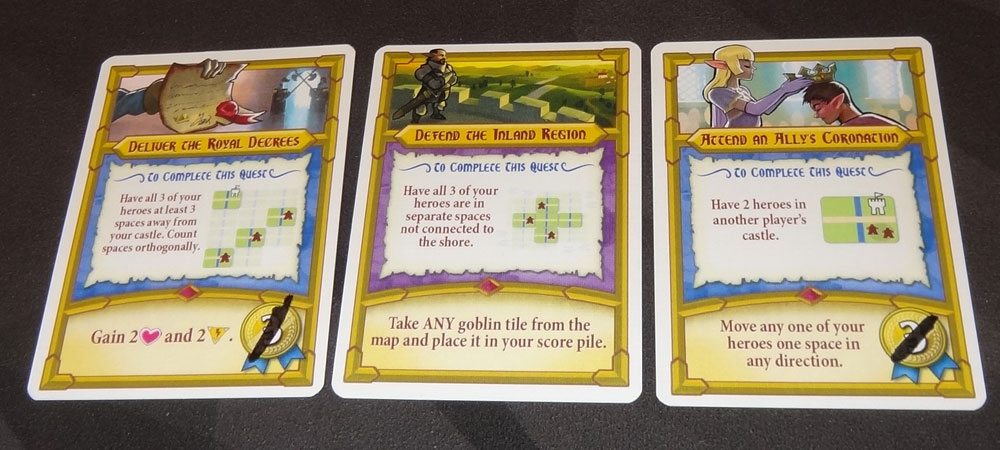
The quest cards all have names that tie thematically to the positions, which is nice. For instance, there’s a quest about attending a coronation that requires you to move two of your heroes to another player’s castle, and each quest card also has artwork representing the quest.

The components that you really want to know about, though, are those newfangled ITEMmeeples. Slightly larger than your standard meeples, the ITEMmeeples are made of plastic and have small holes through the “arms,” allowing them to hold the tiny little plastic items like swords, shields, lanterns, and so on. It is, I have to admit, a little gimmicky—but it’s an adorable, wonderful gimmick. I mean, you could just have cards and three marked meeples to indicate which meeple has which special powers—but the first time a player earned a new item and popped it onto the meeple, all of us got pretty excited.
There are various items that grant special abilities to the meeples holding them, and each meeple is limited to two items in the game. (Physically, you can attach up to four items per meeple, since the holes extend all the way through.) The items are really cute, but tiny—be warned that you’ll need to keep a close eye on them so you don’t lose them. Although my copy of the game is a prototype, the meeples are the same as what will be in the final production; Gamelyn Games wanted to make sure they would work as designed before launching the Kickstarter, so it already invested money in the tools and molds for these.
How to Play
The object of the game is to score the most points in five rounds of play, by completing quests, learning spells, and defeating goblins.
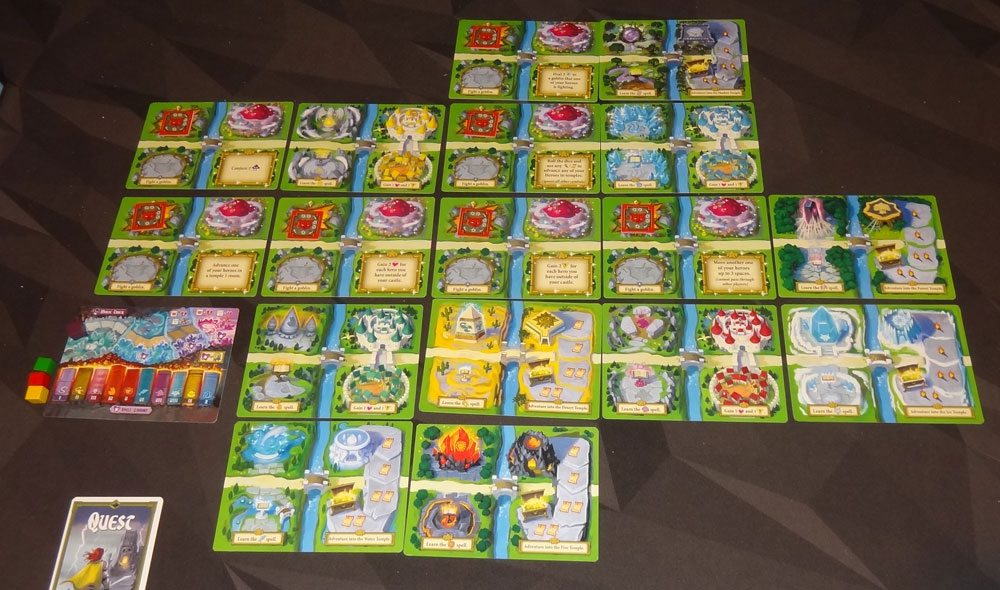
To set up, lay out the 17 map mats to form a large island: the castles are always in the same locations, but the other cards are randomized. Place Goblin tokens on each of the goblin portal spaces, with the “passive” side showing. Each player takes a player mat, preparation card, three Legendary items, a power token, a health token, and three meeples. The Legendary items are placed on the player mats at the far left, and the power and health tokens go on the top of the player mat (at their maximum starting levels of 3 and 6, respectively). Your maximum health will increase if you kill goblins, and your maximum power will increase if you learn spells. The meeples are placed on the board in the castle matching their color.

Shuffle the quest cards and turn 3 face-up. Set the magic mat nearby with the magic token on the first space, and all of the spell tokens just off the mat. Place the 5 movement cards nearby, face-up, along with the dice and the treasure items.
The game is played over 5 rounds, and each round has a day phase and a night phase. During the day, the heroes (meeples) will move around the map, getting into position for adventuring. During the night, heroes will go on adventures and attempt to make their way through temples, learn spells, and defeat goblins.

Day Phase
The 5 movement cards each describe a type of movement: for instance, By Horse lets you travel any number of spaces horizontally, while By Foot lets you travel one space in any direction. For the purposes of movement, a “space” is defined as an entire map mat, not an individual location on a mat. If you move through or onto a space that has an aggressive goblin on it, you flip it over to its passive side, but you must spend 1 power to do so unless you enter the goblin portal to fight it.
The active player will choose the first movement card, and then everyone in turn order gets to use that movement. Then the next player chooses a movement card for everyone to use, and so on, until 4 movement cards have been used. When it is your turn to move, you may also “idle” and not move anyone—if you have at least one meeple in a castle (yours or an opponent’s), you gain 1 power and 1 health.
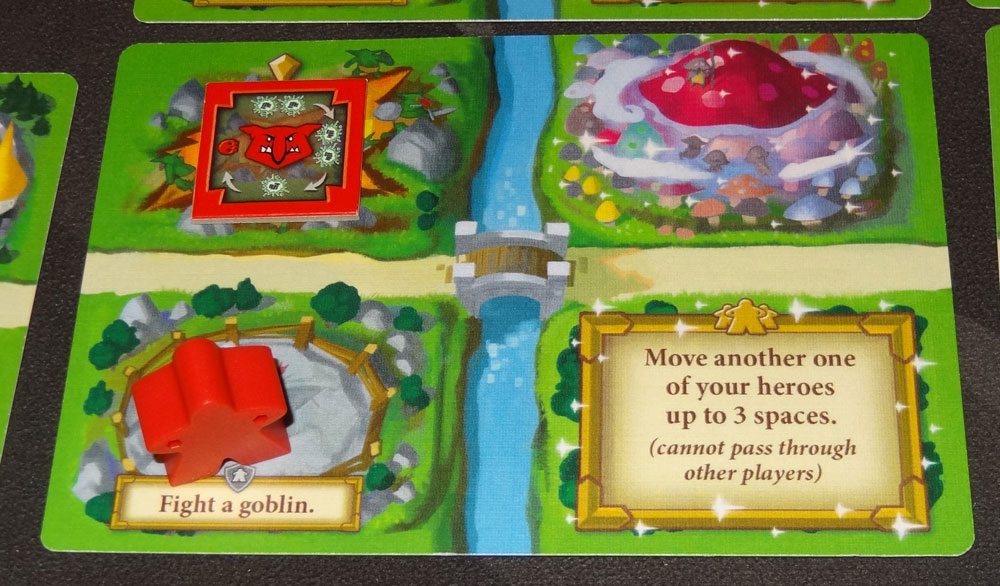
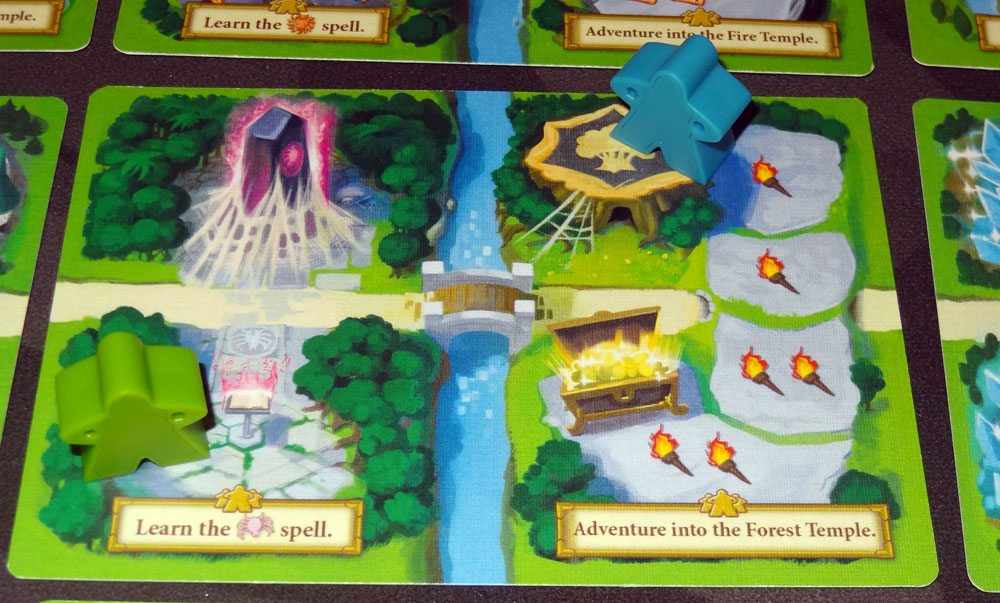
There are a few locations you can go:
- Castles: Gain 1 power and 1 health immediately
- Mushroom Grottoes: Use the printed ability immediately
- Goblin Portals: Fight a goblin during the night phase
- Spell Obelisks: Learn a spell during the night phase
- Temples: Gain a treasure or Legendary item during the night phase
Goblin portals can only hold 1 meeple, temples can hold up to 2 meeples, and the other spaces can accommodate any number of meeples.
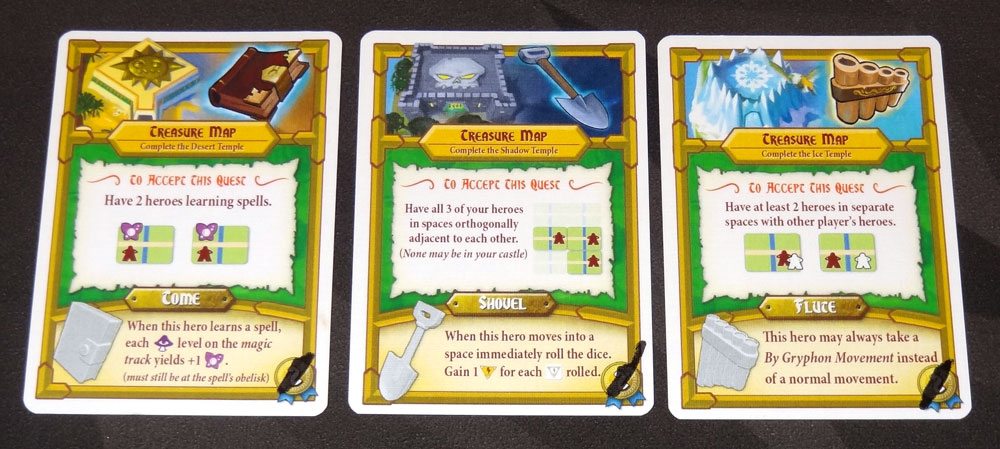
There are two types of quests: basic quests and treasure quests. Basic quests are completed as soon as you claim them, but treasure quests require you to journey through a temple to complete them. In both cases, to claim a quest card, you’ll need to get your meeples into particular positions on the board: maybe all three need to be in temples, or two need to be on opposite sides of the board, or they need to be adjacent to one of your opponent’s meeples. Either way, if you fulfill the requirements for a quest card by the end of your movement, you may take the quest card. If it’s a basic quest, you get the reward right away and place it in your completed quests area. If it’s a treasure quest, you may now enter the appropriate temple (shown on the card) and attempt to acquire the item. Items, once acquired, are placed on the meeple that journeyed through the temple, and award specific bonuses to that meeple.
You may only take one quest card per turn, even if you fulfill the requirements for more than one. Quest cards are refilled as they are taken. Finally, at the end of the phase, if nobody has claimed any quest cards this round, the oldest quest card is discarded and a new one is drawn.
Night Phase
After the four movement cards are resolved, it is time for the night phase.
Starting with the active player, each player will choose to Adventure or Rest. If you Adventure, you roll the dice, which may affect all players who are still adventuring. If you rest, you are done for the round—you will no longer be affected by the dice and will not be able to adventure until the next round.
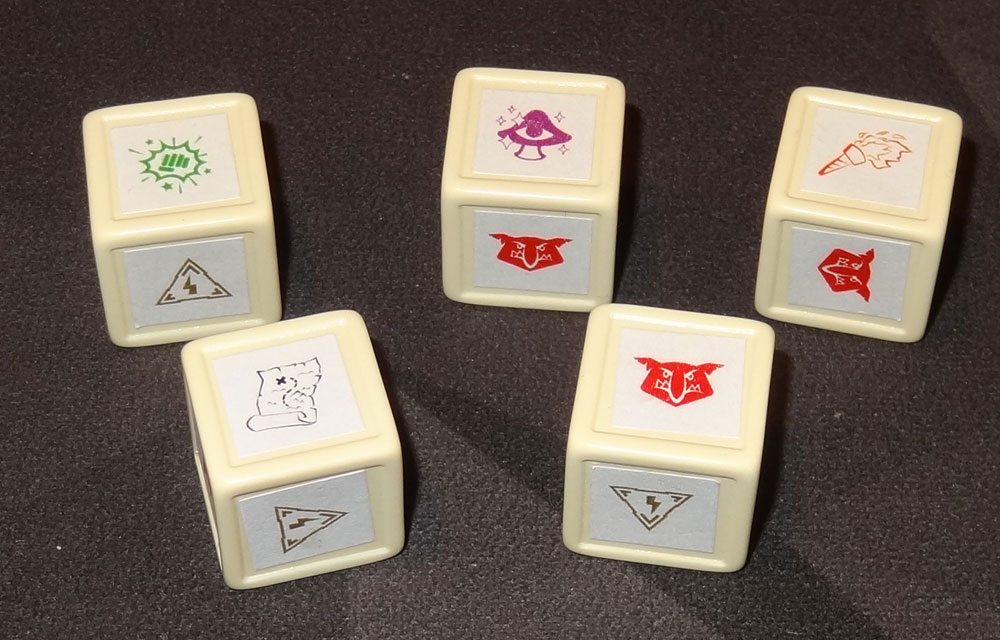
You roll the dice, and then resolve them in this order:
- Goblins: Take 1 wound for each goblin you roll. If you run out of health, you must rest immediately, and also lose 1 level on the spellbook. (You may spend 2 power to defend against 1 goblin die.)
- Power: Gain 1 power for each power symbol you roll.
- Mushroom: Advance the magic token one space.
- Torches/Maps: Every player who is currently in a temple may use the torches or maps rolled to advance in the temple. You must have the requisite number of the right symbol to move into each successive room, and if you reach the treasure room, you receive the reward associated with that temple—either advance your Legendary item on your player mat, or collect the appropriate item and attach it to your meeple. You may spend 2 power as 1 torch or map.
- Attacks: Every player currently engaged with a goblin may use the green fist symbols to attack goblins. You must have enough fists matching the current level in order to rotate the goblin tile. Hit it three times and rotate it to the skull side, and the goblin is defeated and put into your score pile.
After resolving the dice, you pass the dice to the next player who isn’t already resting, and they make a choice to adventure or rest. This continues until all players are resting.
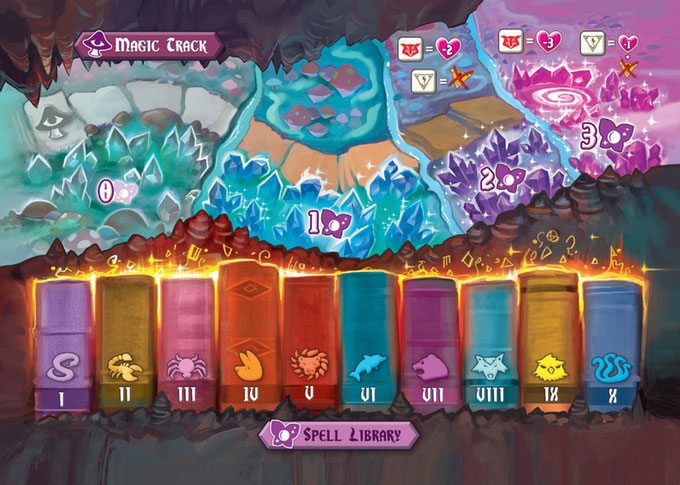
To learn a spell, the magic token must reach a certain threshold on the magic mat. Each mushroom rolled advances the token one space. Depending on where the magic token is, you may increase your knowledge by 1, 2, or 3 levels—but only if you have a hero at the appropriate obelisk. For instance, at the beginning of the game, you are at level 0, so you could attempt to learn the snake (1), scorpion (2), or spider (3). When you rest (without being exhausted), you may increase your spell level based on the current level of the magic token and which obelisks your heroes are at. If you’re at an obelisk but the magic level doesn’t get high enough, or if the magic level goes up but you’re not at an obelisk, you don’t advance your spell level.
The magic level also affects the dice in another way: once the magic reaches spell level 2, every goblin die does 2 damage instead of 1, and the power die does nothing at all. And when the magic level reaches its maximum, goblins do 3 damage and power dice do 1 damage. So the longer you continue questing, the higher you can push the magic level, but the more dangerous it gets—particularly because there’s no way to gain more power to defend against those goblin dice.
Then you reset for the next round: the active player token is passed to the left, the magic token is reset to the beginning, and everyone who was at 0 health or power moves back to at least 1 health and 1 power.
After five rounds, add up scores according to the score chart. For each category—spells, goblins, quests—the chart shows how many points you gain (or lose!) depending on how many of that goal you achieved. In addition, you get 3 points for each Legendary item you acquired. Highest score wins.
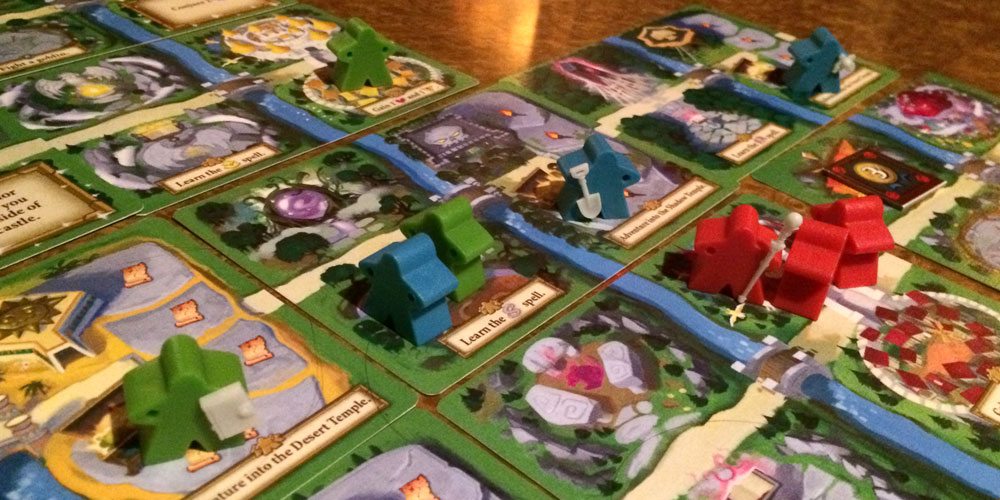
The Verdict
I mentioned Tiny Epic Quest in my Kickstarter roundup last week, but I had just gotten the prototype and hadn’t had time to play through it much yet.
I’ve been a fan of the Tiny Epic series since the beginning: I love the fact that each game packs hefty gameplay into a tiny package (and at a tiny price!), and I’m always excited to see what else Scott Almes and Gamelyn Games are cooking up. True, the tiny size does come with some trade-offs: some people would prefer fold-out boards to the oversize cards, and in some cases a larger format could allow for bigger or more text. Still, for the most part I appreciate the compact size—and it’s clear that many fans do, too. Even though the project just launched last Friday, it has already attracted over 10,000 backers and has raised (as of this writing) over $340k.
I’ve been enjoying a prototype of Tiny Epic Quest and have played with a mix of kids and adults. My kids, of course, loved the ITEMmeeples and couldn’t wait to load them up with various items. In fact, that may be the hardest part of playing this game with kids: they’re gonna want to pick up items and try them out, and it may be hard to keep track of the status of everyone’s Legendary items if they’ve been playing around with them. The game is a fun mixture of various mechanics—some worker placement, some press-your-luck, some resource management—and the theme is nicely done and doesn’t feel pasted-on.
There are a few things that aren’t perfect, though, so I’ll do a little nitpicking first, and then tell you what I do like about it. One minor thing is that the map is oriented in one direction, so it’s easiest to read if you happen to be sitting at the south end of it. In some plays we’ve taken to crowding around the south side of the table so that everyone can read it more easily. Once you’re more familiar with the game, that becomes a little easier. It can also be difficult to spot the specific obelisks at a glance, when you’re looking for a particular spell, and might be nice to have numbers or larger icons on the obelisk spaces. The randomized map does also mean that some players could be at a disadvantage—we had one game where one of the castles was nearly surrounded by goblins, making it very costly for that player to move out except by griffin or by ship.
My prototype included all of the items and corresponding treasure map quests that were initially listed as stretch goals (most of which have been reached), so I’ve been playing with all of those shuffled together. However, it does feel that sometimes this can be a little unbalanced. For instance, early in the game, you want those treasure maps because they will unlock items that then give you some sort of advantage. But later in the game, if the available quests are all treasure maps, players are less likely to go for them—if you spend your movement trying to get into position to claim one, you may not have enough movement left to get to the right temple to get the item, in which case you’ve spent a round getting a quest card that you won’t be able to complete, rather than simply doing something that will get you points immediately. I’m not sure what the best solution is, but I considered separating the basic quests from treasure map quests, and having maybe two of each face up at all times, so that at least you have a choice of which to pursue. Also, the instructions on the quest cards can be somewhat convoluted at times.
My final issue is that, although you do score points for a number of things—spells, goblins, quests, and Legendary items—it doesn’t feel that all of those are equally feasible paths to victory. I’ve only played 4 times so far, but it does feel like learning spells is a more effective way to win than pursuing goblins or quests: not only does it give you points, but it raises the maximum level for your power, which can be spent to defend yourself against goblin attacks, and so forth. Because of the way the magic level works, it’s possible to learn several spells in one round. But I’ve never seen anyone successfully defeat even two goblins in a single round. I’m still curious to see whether it’s possible to win on quests or goblins, but it seems like you have to have a really good luck in which quests are revealed and how the dice roll in order to succeed at those.
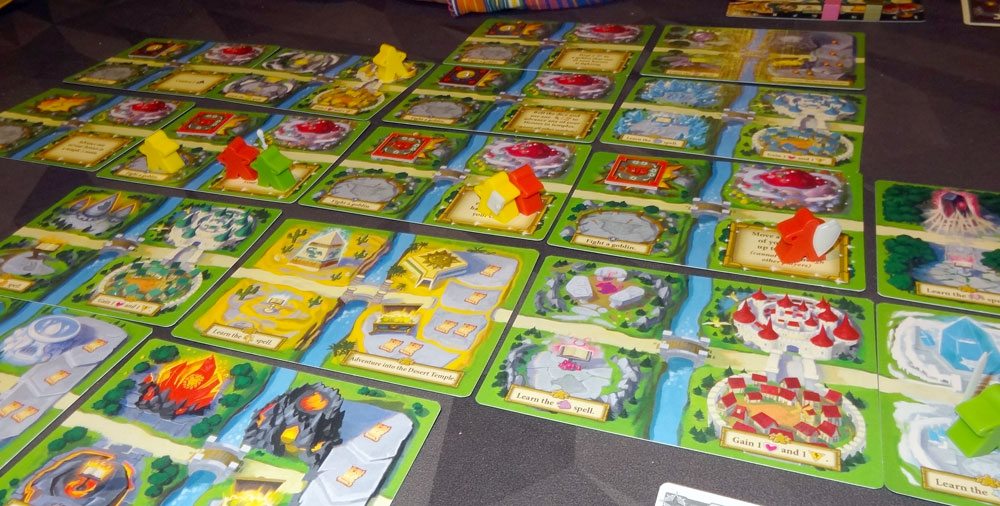
Despite these complaints, though, I still like Tiny Epic Quest. I really like the way the quests work: it’s a trick to move your people into the right positions to claim those quest cards, and if you do it just right, they’ll also be in position to accomplish something useful during the night phase. Planning out your movement, knowing that your opponents will be choosing some of the movement cards, has a puzzle-like feel to it that I enjoyed.
I also like the way the dice work: you’re at risk of losing health when you roll the dice, but you may get some benefit from everyone else’s roll, too, so you usually want other players to continue adventuring as long as possible, so that there are more players to spread out the risks. I also really like the way the magic level works: as you increase, goblins become more dangerous and eventually even power (which is good at the beginning) becomes harmful. It acts almost like a timer mechanism for the night phase, because as players continue to roll, every mushroom makes things a little more volatile, and eventually you won’t have enough power left to defend yourself against goblin attacks.
And despite my complaints about the map, it does look beautiful. The temples and obelisks all have unique art, and the map as a whole is a lot of fun to look at, if a little busy. The individualized artwork on the quest cards is great and helps put you in the role of your characters.
The ITEMmeeples are fun to play with, but they also let you distinguish your three heroes. Once you’ve acquired some items, it becomes very important which hero you send to which location. The meeple with the key should go to the temples, but the meeple with the tome should work on spells. It adds another layer to the movement phase because you don’t want to just move whichever meeple happens to be closest to your destination.
If you’ve enjoyed the previous titles in the Tiny Epic series, well, you’re probably already a backer of this Kickstarter campaign. If you haven’t tried any of them yet, I’ll note that these games are a great buy: for only $20 you get a tiny package that contains an entire world. The gameplay is rich and there are lots of tough decisions to make throughout the game. The series has built up a strong following, and for good reason: Gamelyn Games knows how to run an exciting campaign and how to put together a good game.
For more information or to make your pledge, visit the Tiny Epic Quest Kickstarter page!
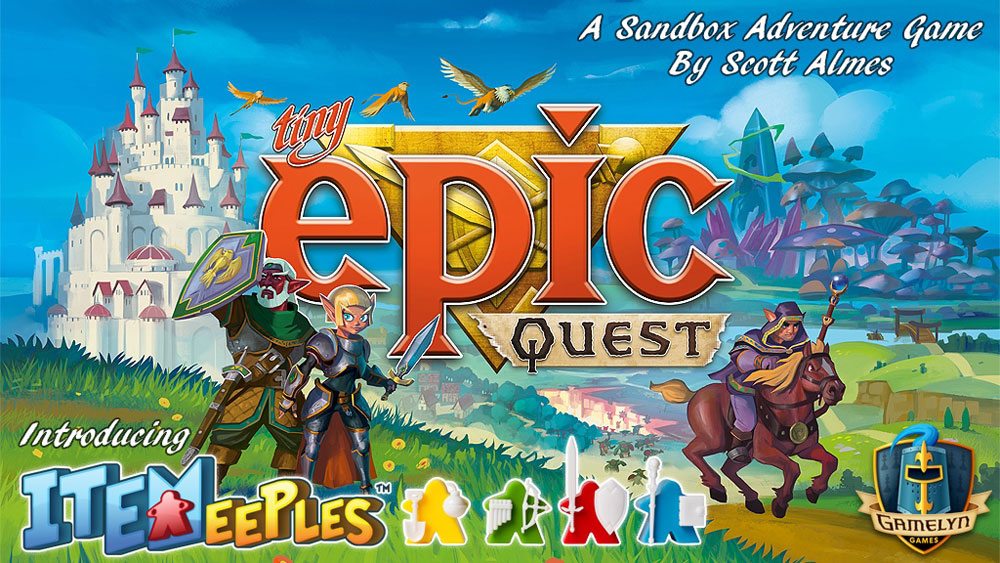



Great review! I’m a huge fan of the Tiny Epic series – was an early backer to Kingdoms back in the day and backed this one as soon as I saw it. Really looking forward to playing with my kids, too. : )
Hi Jonathan
Just discovered another Kickstarter for D&D fans – 3D printed tiles for dungeon maps. It’s pretty cool and my son is already looking forward to printing them out for the game he DM’s (assuming my Tiko ever ships ;-). https://www.kickstarter.com/projects/rocketpiggames/tilescape-dungeons.